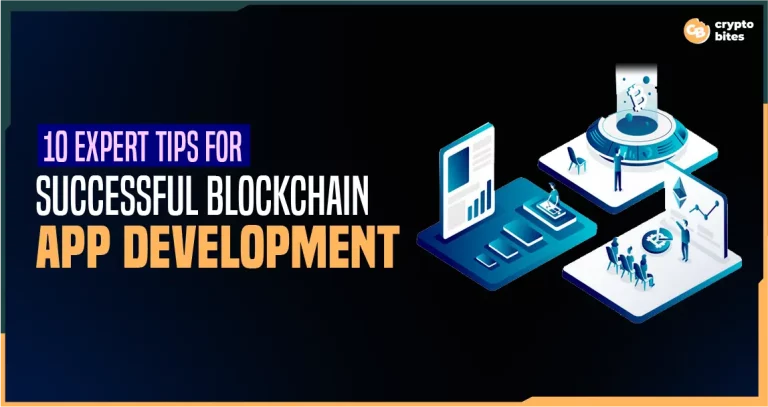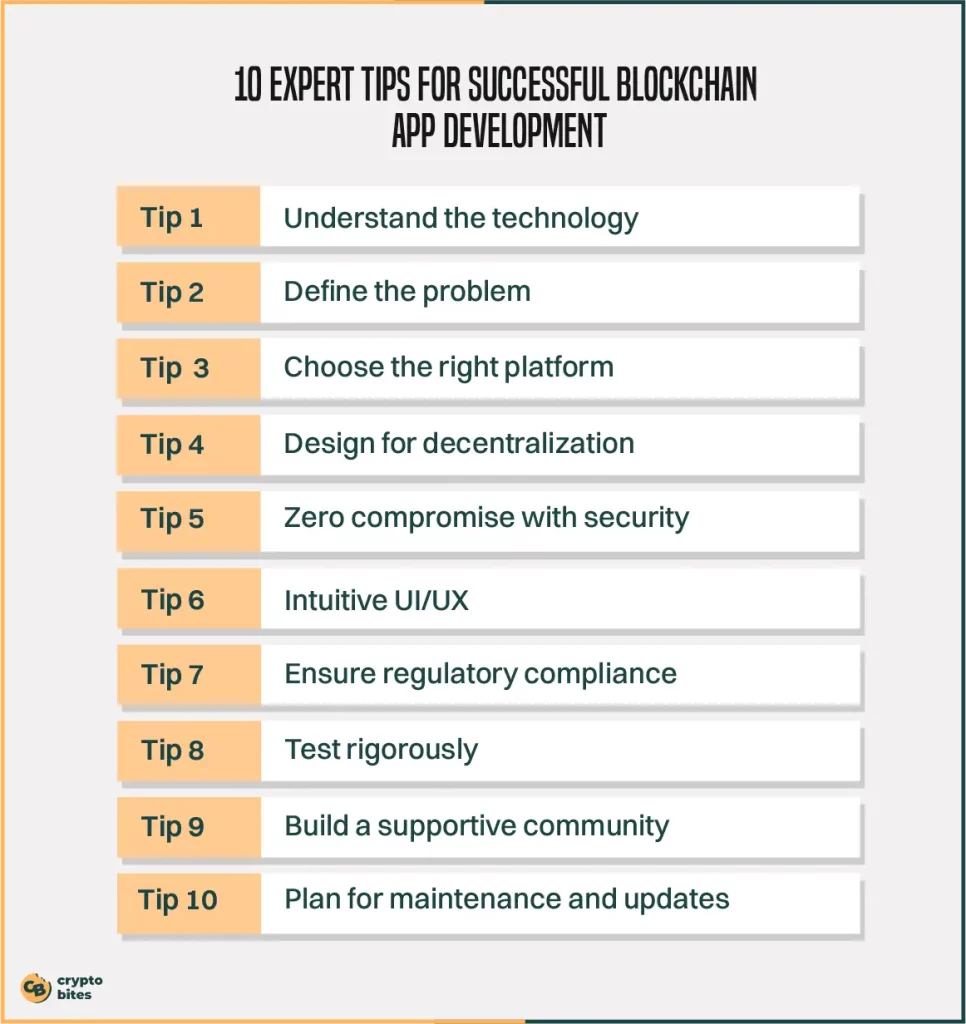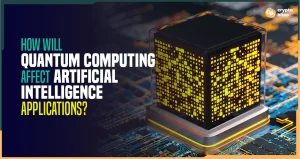
10 Expert Tips for Successful Blockchain App Development
Is knowing blockchain and some programming enough? Can it lead to successful blockchain app development? In my perspective, it requires a lot more than that. You will need to understand the technology and its limits. You also need in depth knowledge of business processes and so on.
If you’re thinking of developing a blockchain app, you should keep certain things in mind to ensure its success. This blog will surely help you with that. Keep reading to find out the top 10 expert tips for successful blockchain app development.
Key Takeaways
- All about blockchain app development
- Different types of blockchain apps and their functionality
- Expert tips for successful blockchain app development
- Guideline to develop blockchain app with AI integration
What Is Blockchain App Development: Today and Tomorrow
Blockchain app development is the process of creating applications that use blockchain technology as their underlying platform.
You may be familiar with the concept of blockchain as a decentralized ledger system, right? Then what exactly are blockchain apps? Blockchain apps are decentralized applications (DApps) operating on a peer-to-peer network, free from centralized control.
Leveraging blockchain technology, these apps ensure secure and transparent data storage and transaction mechanisms.
In the technology and economic balancing trend, the new way of developing apps with blockchain is taking center stage. From finance to healthcare and even supply chain management, this technology is disrupting various sectors with its decentralized and secure nature.
According to the Developer Report, as of October 2022, the global count of active blockchain developers stood at 26,700. However, by October 2023, there had been a 27% decline, reducing the developer count to 19,300.
Don’t be disappointed, though. The reason behind such decline could be attributed to the departure of part-time Bitcoin developers and individuals engaged in various blockchain projects.
With the growing adoption of blockchain technology in businesses, the demand for blockchain app developers is projected to rise in the upcoming years.
In the emerging AI and IoT era, the significance of blockchain app development will further intensify. Thus, there is a pressing need to embrace this technology and create innovative blockchain applications.
Types of Blockchain Apps
Before you become a developer of blockchain apps, you must know all their types. Broadly, there are five significant types of blockchain apps.

Type 1. Financial Blockchain Apps
Also known as Decentralized Finance or DeFi apps, these apps primarily deal with financial transactions and monetary assets. They are built on blockchain networks and offer lending, borrowing, trading, and more features.
These apps are more secure and transparent. They also remove the need for middlemen, like banks.
There are other types of blockchain apps, too. These include crowdfunding platforms, investment apps, and more. Plus, auction, gaming, gambling, and prediction market platforms also fall under the Financial apps category.
For example, apps like MakerDao and Compound are on the Ethereum blockchain. They offer lending and borrowing.
Type 2. Non-Financial Blockchain Apps
While financial apps deal with monetary transactions, non-financial blockchain apps have a more comprehensive range of use cases. These can include supply chain management, identity verification, data storage and sharing, voting systems, and more.
The major advantage of using blockchain for these types of apps is the immutability of data. Once information is recorded on the blockchain, it cannot be altered or deleted. This makes it ideal for blockchain use cases where security and transparency are paramount.
One example of a non-financial app is Everledger, which uses blockchain to track the supply chain of diamonds.
Type 3. DAOs
Decentralized autonomous organizations (DAOs) are like super ambitious DApps in the crypto scene. They aim to create a company without a boss. They set rules on how members can jump in, vote, or handle company funds during development. In crypto, DAOs run on smart contracts, which is why Ethereum paved the way for their infrastructure.
Although they are still in their early stages, DAOs can offer businesses a new level of decentralization and transparency.
The DAO, a well-known instance of a DAO, is a blockchain-based venture capital fund. It successfully raised over $150 million in Ether in 2016. However, it fell victim to a hack stemming from vulnerabilities in the code base.
Type 4. Asset Management Blockchain Apps
Blockchain-based asset management apps help trade, track, and manage assets like real estate, stocks, and metals. These apps use smart contracts, which ensure safe and clear ownership records.
With traditional asset management systems, there is always a risk of fraud or errors in record keeping. Blockchain eliminates these risks by providing an immutable and decentralized ledger system. This can bring a higher level of trust and security to the asset management industry.
Type 5. Network Administering Blockchain Apps
Network administering blockchain apps means creating and managing networks of blockchain nodes. These applications function as a monitoring system for the blockchain network, ensuring its smooth operation.
They also provide information about transactions and blocks on the network. This helps developers find any issues or bugs.
Let’s discuss the types of blockchain networks. The two most popular ones are public and private networks.
Anyone with internet access can access public blockchain networks like Bitcoin or Ethereum. Private blockchain networks, on the other hand, require permission to access them. It makes them more suitable for businesses looking for a secure yet efficient way of managing their data.
With network administering blockchain apps, businesses can effectively monitor and manage their internal blockchain networks.
10 Expert Tips for Successful Blockchain App Development
Now that you know about the different types of blockchain apps, it’s time to learn 10 expert tips that will help you develop successful ones.

Tip 1. Understand the technology
Blockchain technology may seem complex, but first, you must have a clear understanding of how it works before diving into development. This will help you make informed decisions and avoid potential mistakes that could cost time and resources.
For example, if you look into the types of consensus algorithms, you might learn that Proof-of-Work (PoW) and Proof-of-Stake (PoS) each have pros and cons. Understanding these differences can help you choose the most suitable algorithm for your app.
Tip 2. Define the problem
As a professional developer, more than technical knowledge is required. You have to define a particular problem. This clarity guides the development process and ensures your app has a clear value proposition for its users.
For instance, consider a supply chain management app. The problem might be the lack of transparency and inefficiency in tracking products’ origins and handling.
Using blockchain, your app could provide an unchangeable ledger. It would ensure that all parties in the supply chain have access to realtime data.
Tip 3. Choose the right platform
Several blockchain platforms are available, each with its own features and programming languages. Some popular options include Ethereum, Hyperledger, and EOS. Choose a platform that aligns with your app’s requirements and your technical expertise.
Let’s elaborate with an example. Ethereum is a popular choice for developing smart contracts due to its Solidity programming language. However, Hyperledger might be a better fit for your project if you are more comfortable with Java than Solidity.
Tip 4. Design for decentralization
Blockchain is all about decentralization. When designing your app, ensure it follows the principles of decentralization.
For example, it should have no single point of failure and use distributed consensus. This will make your app more secure and give you a competitive edge in the market since users are increasingly drawn to decentralized solutions.
So, how do you design your app for decentralization? Consider using peer-to-peer (P2P) communication. Also, use a distributed network to spread the workload among nodes on the blockchain. Plus, ensure that there is no central authority controlling the network.
Tip 5. Zero compromise with security
Remember, your app will be handling sensitive data and financial transactions. There is no room for compromise when it comes to security.
Here are a few things you need to focus on-
- Code optimization: Write efficient code and avoid common vulnerabilities like reentrancy attacks.
- Smart contract auditing: Thoroughly audit your smart contracts to eliminate any potential bugs or security loopholes. Consider hiring a third-party auditor for an unbiased review.
- Continuous integration and deployment: Establish robust continuous integration and deployment (CI/CD) pipelines for your blockchain application. These pipelines will automate building, testing, and deploying the application.
- Privacy-preserving techniques: Consider using privacy-preserving techniques like zero-knowledge proofs. It will safeguard sensitive data from public view.
- Interoperability: Interoperability allows different blockchain networks to communicate, expanding your app’s potential use cases and increasing its user base.
- Formal verification: Consider using formal verification to mathematically prove that your smart contracts are free from errors and vulnerabilities.
- Immutable data storage: Blockchain’s immutability can be used to store critical data, such as transaction records or user identities. This ensures that the data is tamper-proof and transparent.
All these measures will greatly enhance the security and reliability of your blockchain app.
Tip 6. Intuitive UI/UX
Even with all the best features and security, it will only be successful if your app has a good user interface or experience. Users should find your app easy to navigate and understand, regardless of their technical expertise.
Ensure a user-friendly design and layout with clear instructions and action prompts. Interact with beta testers and gather feedback to improve the user experience continuously.
You may also use visual aids like charts, graphs, and diagrams to present complex data in a more user-friendly manner.
Tip 7. Ensure regulatory compliance
Ensuring regulatory compliance is key in developing blockchain apps. Failure to follow rules can lead to hefty penalties and loss of trust.
Research and understand the legal requirements specific to the region or industry where your app will operate. This includes data protection laws, financial regulations, and any blockchain-specific legislation.
For example, if your blockchain app involves processing the personal data of EU citizens, it must follow the General Data Protection Regulation (GDPR). One of the GDPR requirements is the right to erasure, also known as the right to be forgotten.
However, blockchain’s immutable nature makes this challenging. You could design your app to store personal data off-chain to address this. It can be modified or deleted there. Meanwhile, the app can keep transaction records on the blockchain. This approach balances compliance with GDPR and the benefits of blockchain technology.
Additionally, you must understand and comply with the Anti-Money Laundering (AML) and Know Your Customer (KYC) regulations for apps involved in financial transactions.
For instance, adding an AML/KYC procedure to your app’s user registration ensures that your app meets financial rules. You could also require users to upload a government-issued ID for verification before engaging in financial transactions on the platform.
Tip 8. Test rigorously
Blockchain apps require extensive testing to ensure that they function as intended and are secure.
- Functional testing: Test the functionality of your app by simulating different user actions and interactions with the blockchain network. This includes testing for edge cases and error-handling scenarios.
- Security testing: Perform rigorous security testing, including penetration testing, to identify and address any vulnerabilities in your app.
- Performance testing: Test your app’s performance by simultaneously simulating many transactions and users. This will help identify any bottlenecks or scalability issues that need to be addressed.
Regular testing at every stage of development ensures a stable, secure, and functional blockchain app for your users.
Tip 9. Build a supportive community
One supportive community can make all the difference in the success of your blockchain app. Engage with your users, listen to their feedback and suggestions, and actively involve them in the development process.
Create social media channels or forums for discussions, updates, and announcements about your app. Encourage community members to share their experiences. Promote your app through word-of-mouth. They will also provide valuable insights for improvement.
A strong community helps with user retention and acquisition and adds credibility to your app.
Tip 10. Plan for maintenance and updates
Blockchain technology is constantly evolving, and so should your app. Plan for regular maintenance and updates to fix bugs, add new features, and keep up with the latest advancements in the blockchain space. This will not only improve user experience but also ensure the long-term success of your app.
Consider setting aside a dedicated team or budget for ongoing maintenance and updates. Additionally, communicate these updates and their benefits to your users, keeping them engaged and informed about the app’s progress.
Steps Involved in Blockchain App Development
Here few steps that are usually followed while during blockchain app development process:
Step 1 – Identify the Problem to Be Solved
Identifying the customer pain point and how it is going to be solved is the first step in the blockchain app development process,. It’s crucial to ensure that blockchain is indeed the optimal solution for this challenge.
After all, blockchain technology isn’t a universal fix, but when it’s the right fit, it can work wonders.
Step 2 – Define Project Scope and Requirements
Once you’ve found a good reason to pursue a project, it’s crucial to carefully outline what needs to be done. This means clearly defining both the business goals – like the financial and strategic targets you want to hit – and the detailed technical requirements.
Think of it as creating a thorough plan that will steer the development process in the right direction, making sure everyone involved is on the same page.
Step 3 – Identify a Consensus Mechanism
As we explore further, choosing the right consensus mechanism becomes increasingly important. This mechanism determines how participants in the blockchain network agree on the validity of transactions.
There’s a range of options available, from the widely used Proof of Work (PoW) to Proof of Stake (PoS) and various Byzantine Fault Tolerance (BFT) protocols. Each mechanism has its own advantages and factors to consider, so a careful evaluation is needed to find the one that best fits the application’s particular needs.
Step 4 – Choose the Right Blockchain Platform
Choosing the right blockchain platform is a critical decision. The platform you select can greatly affect the capabilities of your development team and the overall direction of the project.
By conducting thorough research, we aim to find a platform that not only meets the technical requirements but also drives the application towards its long-term business goals.
Step 5 – Analyze the Market
To gain a strategic advantage in the market, it’s crucial to thoroughly analyze your competitors. This involves examining their strengths, weaknesses, features, pricing strategies, and market positioning.
By understanding these aspects, you can identify opportunities for your application to excel and refine your product concept for optimal impact.
Exploring customer reviews provides valuable insights into user experiences too, highlighting areas for improvement and revealing unmet needs that your innovative application can fulfill.
Target audience should also be taken into consideration. Here are few things that need to be looked at to understand your target audience:
- Demographics: Age, gender, income, location (consider if relevant)
- Psychographics: Goals, challenges, motivations, personality type
- Professional Background: Qualifications, current job, past experiences (consider if relevant)
- Interests and Preferences: Personal tastes and habits
- Needs: Why would this person need your blockchain product? What problem does it solve for them?
Step 6 – Write the Actual Code
Once you have a clear understanding of your market and target audience, you can begin translating your product concept into code.
Begin by outlining the key features and functionalities of your blockchain product. Break down these features into smaller tasks or modules that you can tackle one at a time.
Choose the appropriate blockchain platform or technology stack for your project. This could include platforms like Ethereum, Hyperledger Fabric, or building a custom blockchain solution.
Iterate on your code based on feedback from testing and validation processes.
Be prepared to make adjustments or refinements as needed to ensure your product meets the needs of your target audience and stands out in the market.
Throughout this process, maintain a balance between market analysis and code implementation.
Continuously gather feedback from users and stakeholders to inform your development process and make data-driven decisions about feature prioritization and product enhancements.
How do you develop a blockchain app with AI integration?
Integrating Artificial Intelligence (AI) into blockchain applications opens up many opportunities for enhanced functionality, automation, and efficiency. Following are several strategies for creating blockchain apps with AI integration:
Predictive Analytics
AI can analyze patterns and predict future outcomes based on historical blockchain data. This is particularly useful in finance and supply chain management.
Example: A blockchain app for stock trading can integrate AI to predict stock prices based on past performance and market trends. The AI analyzes vast amounts of data on the blockchain to provide users with investment recommendations.
Smart Contracts Automation
AI algorithms can automatically execute, control, or document legally relevant events according to the contract terms stored on the blockchain.
Example: In the insurance industry, an AI-integrated blockchain app could automatically adjust premiums or process claims based on user behavior or reported incidents. If AI detects a low risk of accidents through user driving data, it could automatically lower car insurance premiums.
Fraud Detection
Integrating AI for realtime monitoring and analysis can significantly enhance the security of blockchain apps by detecting and preventing fraudulent activities.
Example: A blockchain-based payment app could use AI to analyze transaction patterns and flag potentially fraudulent transactions. The AI could learn from past fraud data, use the data to find suspicious activity and cut financial losses.
Enhanced User Interactions
Through chatbots or voice assistants, AI can provide users with a more intuitive and interactive way to engage with blockchain applications.
Example: A decentralized finance (DeFi) application could use an AI-powered chatbot. The chatbot would offer financial advice, suggest investments, and explain complex terms and conditions, making blockchain technology more accessible to users.
Data Privacy and Protection
AI can play a big role in improving data privacy and protection in blockchains. It does this by finding and fixing flaws.
Example: An AI algorithm could analyze access patterns to sensitive data stored on a blockchain and predict potential data breaches before they occur. Recognizing unusual patterns could trigger additional security protocols or alert administrators.
Supply Chain Optimization
AI can optimize supply chain processes by predicting demand, managing inventory, and identifying the most efficient delivery routes.
Example: An AI-integrated supply chain management app can forecast product demand more accurately, ensure that inventory levels are optimized, and plan transportation routes to cut delays and costs.
Overall, adding AI to blockchain applications enhances their capabilities and creates a new level of efficiency and user experience.
Conclusion
Once you understand your audience, identify the problem your app will solve, and use these tips in your development, you are on your way to creating a successful blockchain app.
By prioritizing security, user experience, compliance, testing, community building, and maintenance, you can build an app that users will trust and enjoy using.
FAQs
What are some examples of successful blockchain apps?
Here are some examples of successful blockchain apps.
- Cryptocurrency wallets and exchanges, such as Coinbase and Binance.
- Supply chain management solutions, like IBM’s Food Trust or Provenance.
- Healthcare data management apps, like MedRec or Mediledger.
- Decentralized applications (dApps) for gaming, social media, or file storage, such as Gods Unchained or Steemit.
- Identity verification and management apps like Civic or SelfKey.
- Peer-to-peer marketplaces for goods and services, such as OpenBazaar or BitBoost.
Which languages are used for blockchain app development?
Some popular languages used for blockchain app development include:
- Solidity (used for Ethereum smart contract development)
- Java
- Python
- GoLang
- C++
Choose a language that is well-suited for your app’s specific features and functions and has good community support and resources. For example, Java is a popular choice for developing enterprise blockchain solutions, while Solidity is preferred for decentralized apps (DApps) on the Ethereum network.
How do I become a blockchain app developer?
To become a blockchain app developer, you will need a strong understanding of blockchain technology and its underlying principles, as well as programming skills in one or more app development languages.
There are many online resources, courses, and certifications available that can help you learn these skills. For instance, you can take online courses on sites like Coursera or Udemy, join blockchain developer communities and forums, and practice by building simple apps.
Also, gaining hands-on experience is key. This can be done by participating in hackathons or contributing to open-source projects. It is beneficial for becoming a skilled blockchain app developer.
How much does it cost to build a blockchain app?
The cost of developing a blockchain app typically falls between $15,000 and $60,000. However, this estimate can change significantly, depending on factors such as app complexity, features, team size, and location.
Sources
2. https://radixweb.com/blog/how-to-develop-blockchain-application




